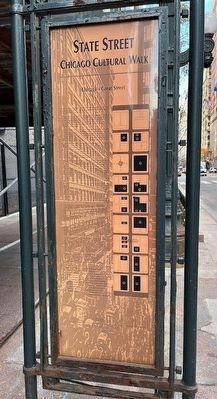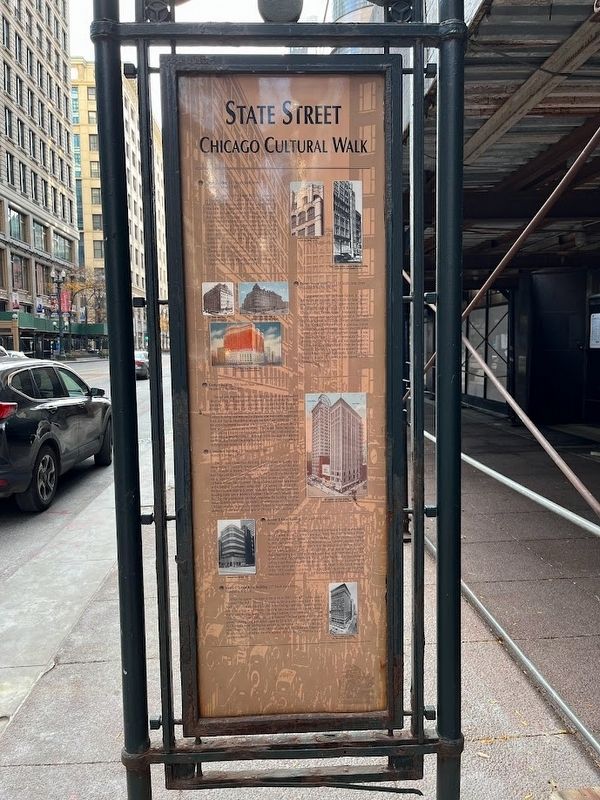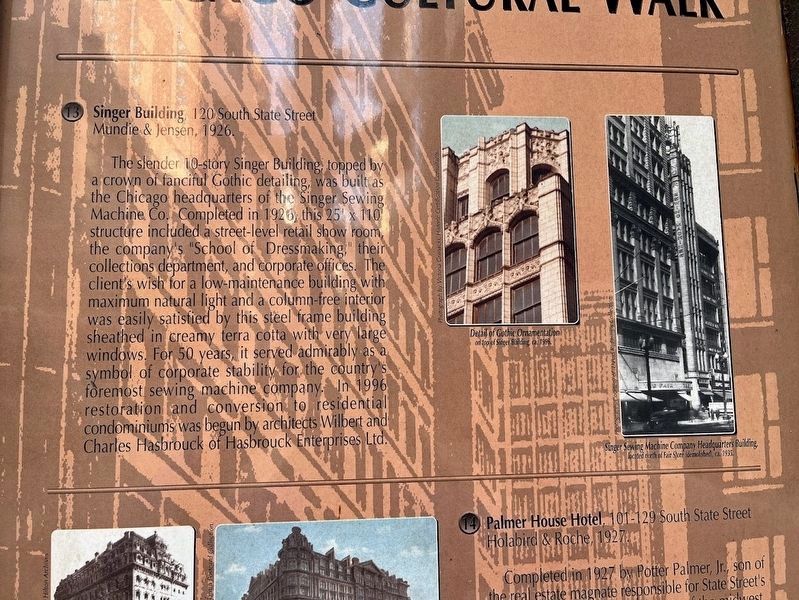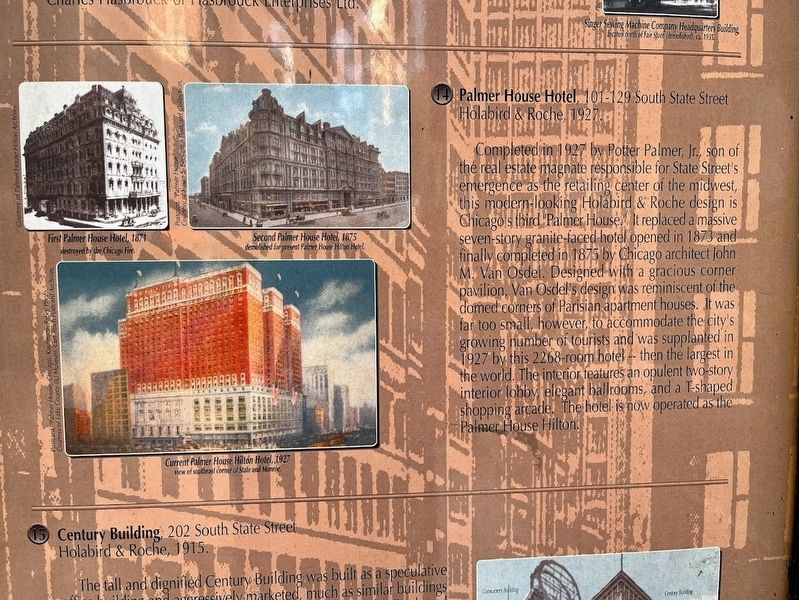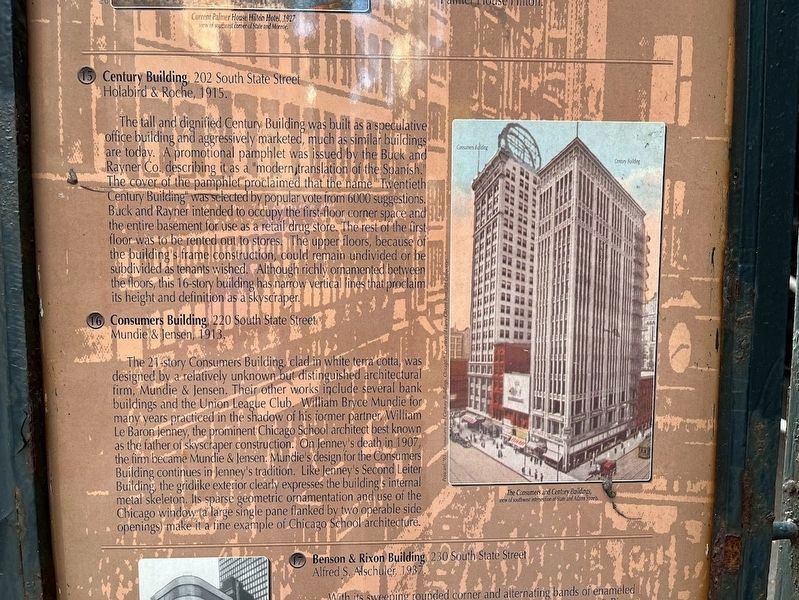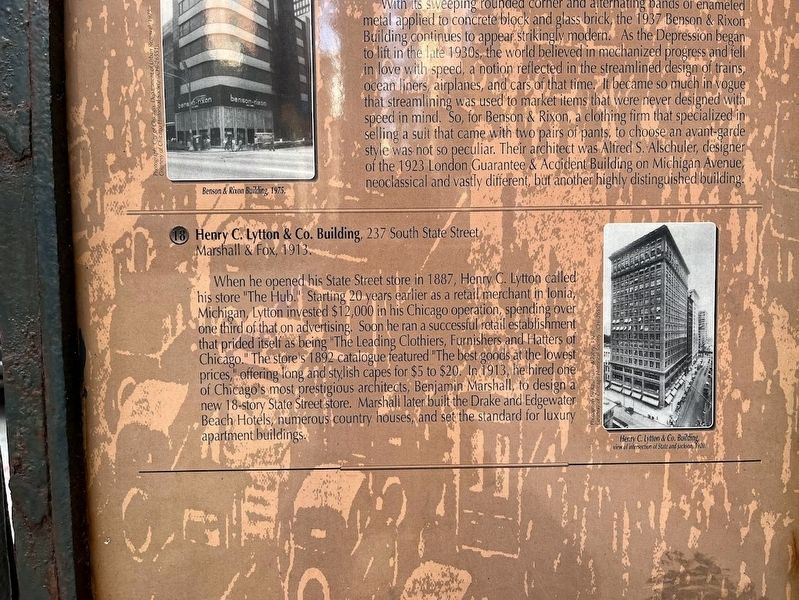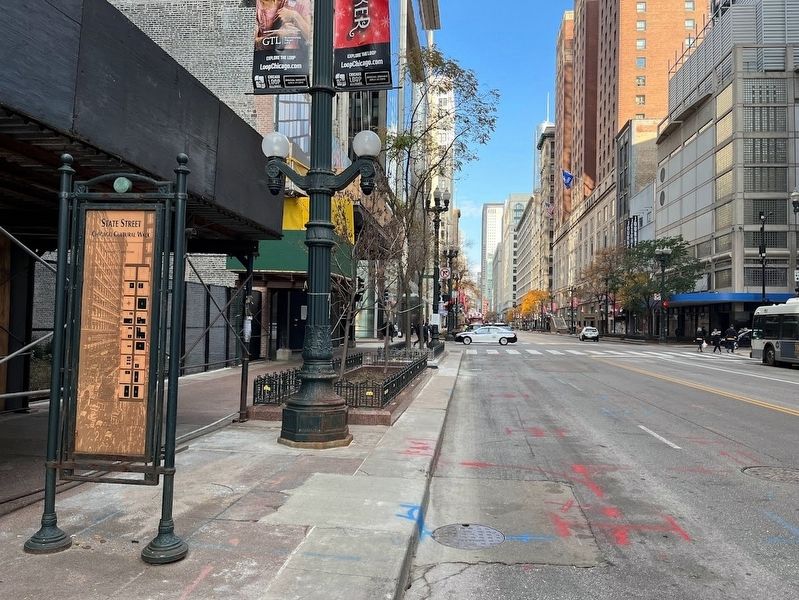The Loop District in Chicago in Cook County, Illinois — The American Midwest (Great Lakes)
State Street
Chicago Cultural Walk
[side 1]
Chicago’s Great Street
There is only one State Street. Widely celebrated in song, “That Great Street” has been known since the 1870s for its concentration of premier department stores and world-class architecture.
Chicago's earliest shopping district was located along Lake Street. Parallel to the Chicago River and only one block south, Lake Street absorbed the traffic in commerce that already existed along the river’s edge. State Street developed when entrepreneur Potter Palmer recognized that the curve of the river would limit Chicago's potential economic growth and envisioned State is the city’s major retailing thoroughfare.
State Street in the 1860s was a narrow, unpaved street edged by wooden sidewalks and a confusion of small shops. Palmer, who had been in business with Marshall Field and Levi Leiter in a Lake Street store before the Civil War, translated his dream into reality by purchasing a ¾ mile stretch of land along State Street, convincing Field and Leiter to open the street’s first major department store at the northeast corner of State and Washington Streets.
By 1870, State Street had become Chicago’s shopping destination. Widespread destruction caused by the Chicago Fire of 1871 merely delayed its growth. Find the 1890s, State Street was home to Chicago's finest retail establishments, with the more prestigious and expensive stores clustered at the north end and the more popular stores carrying a greater variety of merchandise at the south end. When the city's first subway system was completed under State Street in 1943, it provided for direct pedestrian connections from the mezzanine level stations to the basements of many of the department stores.
Department store architecture is as important to Chicago as State Street’s retailing history. It reflects the genius of the city's earliest great designers. Lining State Street are buildings by William Le Baron Jenney and the architects who trained under him: Louis Sullivan, William Holabird, Martin Roche, and Daniel Burnham. Taking advantage of Chicago's location as a railroad hub, its rapid commercial expansion in the lumber, coal, and steel industries, its population explosion (Chicago tripled in size between 1870 in 1890), and its immediate need to rebuild following the Chicago Fire, these men set out to create a new building type with a whole new look. Because Chicago’s central business district was restricted in size by Lake Michigan, the Chicago River and, to the south, railroad yards, the only direction to build was up. The result was the skyscraper.
The commercial style developed by these pioneers in Chicago's Loop between 1880 and 1910 became known as the “Chicago School of Architecture.” Recognized world-wide for its modernism, the style of these Chicago School skyscrapers had no precedent. Their exterior design looks like a grid, an expression of the building’s interior metal frame, and ornamentation was generally simple and nonhistorical. The style is an outgrowth of major advances in technology. Steel frame construction, developed in the 1880s, meant that tall buildings with flexible floor plans could be erected quickly and cheaply. The first sheets of plate glass rolled in the 1880s allowed for maximum light and ventilation. Faster and safer elevators in the 1870s made tall buildings practical, and new fireproofing techniques made them safe.
In 1893, Jenney firmly established his reputation as a pioneer in the development of steel skeleton construction, designing huge buildings to house Siegel, Cooper & Co. (known as the Second Leiter Building) and the Fair Store (demolished). Distinguished by broad open floor space, impressive height, and simplified exteriors, both ushered in the era of the “Big Store.”
Carson, Pirie Scott & Co., before moving to its current location, operated on the ground floor of the Reliance Building. This tall narrow building sheathed in white terra cotta, was designed by Burnham and Root. It is universally recognized as one of Chicago’s most distinguished early steel and glass skyscrapers. In 1899, Louis Sullivan began designing the Schlesinger and Mayer Store building, which has housed Carson’s since 1904. There is no finer example of a simple, elegant Chicago School building. Like numerous other buildings of the Chicago School located along State Street, such as the Mandel Brothers Building and the A.M. Rothschild & Co. Building, Carson's interior metal frame is expressed in a gridlike exterior design. In addition, Sullivan’s highly original ornamentation embellishes the frame.
Several handsome commercial buildings never intended for department store use also dot the street. The Chicago Building, by Holabird & Roche, is among the city’s stellar Chicago School office buildings. Rapp & Rapp’s 1921 Chicago Theatre recalls romantic time of movie palaces. The elegantly detailed Mentor Building, designed by Howard Van Doren Shaw, echoes the design ingenuity typically found in his beautiful country houses. The current Palmer House Hilton is the third Palmer House Hotel and serves as a constant reminder that Potter Palmer was State Street’s major developer.
Department stores and significant architecture tell the story of State Street. As the 20th century progressed, retailing became firmly established―anchored by numerous distinguished department stores. At the same time many of the city's finest Chicago School buildings were constructed. State Street reflects Chicago's mercantile beginnings: its history is rich and its architecture is splendid.
[side 2]
13. Singer Building, 120 South State Street
Mundie & Jensen, 1926.
The slender 10-story Singer Building, topped by a crown of fanciful Gothic detailing, was built as the Chicago headquarters of the Singer Sewing Machine Co. Completed in 1926, this 25' x 110' structure included a street-level retail show room, the company's "School of Dressmaking," their collections department, and corporate offices. The client's wish for a low-maintenance building with maximum natural light and a column-free interior was easily satisfied by this steel frame building sheathed in creamy terra cotta with very large windows. For 50 years, it served admirably as a symbol of corporate stability for the country's foremost sewing machine company. In 1996 restoration and conversion to residential condominiums was begun by architects Wilbert and Charles Hasbrouck of Hasbrouck Enterprises Ltd.
14. Palmer House Hotel, 101-129 South State Street
Holabird & Roche, 1927.
Completed in 1927 by Potter Palmer, Jr., son of the real estate magnate responsible for State Street's emergence as the retailing center of the midwest, this modern-lookin Holabird & Roche design is Chicago's third "Palmer House." It
replaced a massive seven-story granite faced hotel opened in 1873 and finally completed in 1875 by Chicago architect John M. Van Osdel. Designed with a gracious corner pavilion, Van Osdel's design was reminiscent of the domed corners of Parisian apartment houses. It was far too small, however, to accommodate the city's growing number of tourists and was supplanted in 1927 by this 2268-room hotel -- then the largest in the world. The interior features an opulent two-story interior lobby, elegant ballrooms, and a T-shaped shopping arcade. The hotel is now operated as the Palmer House Hilton.
15. Century Buliding, 202 South State Street
Holabird & Roche, 1915.
The tall and dignified Century Building was built as a speculative office building and aggressively marketed, much as similar buildings are today. A promotional pamphlet was issued by the Buck and Rayner Co. describing it as a "modern translation of the Spanish." The cover of the pamphlet proclaimed that the hare Twentieth Century Building" was selected by popular vote from 6000 suggestions. Buck and Rayner intended to occupy the first-floor corner space and the entire basement for use as a retail drug store. The rest of the first floor was to be rented out to stores. The upper floors, because of the building's frame construction, could remain undivided or be subdivided as tenants wished. Although
richly ornamented between the floors, this 16-story building has narrow vertical lines that proclaim. its height and definition as a skyscraper.
16. Consumers Building, 220 South State Street
Mundie & Jensen, 1913.
The 21-story Consumers Building, clad in white terra cotta, was designed by a relatively unknown but distinguished architectural firm, Mundie & Jensen. Their ether works include several bank buildings and the Union League Club. William Bryce Mundie for many years practiced in the shadow of his former partner William Le Baron Jenney, the prominent Chicago School architect best known as the father of skyscraper construction. On Jenney's death in 1907, the firm became Mundie & Jensen. Mandie's design for the Consumers Building continues in Jenney's tradition. Like Jenney's Second Leiter Building, the gridlike exterior clearly expresses the building's internal metal skeleton. Its sparse geometric ornamentation and use of the Chicago window ta large single pane flanked by two operable side openings make it a line example of Chicago School architecture.
17. Benson & Rixon Building, 230 South State Street
Alfred S. Alschuler, 1937.
With sweeping rounded corner and alternating bands of enameled metal applied to concrete block and glass brick, the 1937 Benson & Rixon Building continues to appear strikingly modern.
As the Depression began to lift in the late 1930s, the world believed in mechanized progress and fell in love with speed, a notion reflected in the streamlined design of trains, ocean liners, airplanes, and cars of that time. It became so much in vogue that streamlining was used to market items that were never designed with speed in mind. So, for Benson & Rixon, a clothing firm that specialized in selling a suit that came with two pairs of pants, to choose an avant-garde style was not so peculiar. Their architect was Alfred S. Alschuler, designer of the 1923 London Guarantee & Accident Building on Michigan Avenue, neoclassical and vastly different, but another highly distinguished building.
18. Henry C. Lytton & Co. Building, 237 South State Street
Marshall & Fox, 1913.
When he opened his State Street store in 1887, Henry C. Lytton called his store "The Hub." Starting 20 years earlier as a retail merchant in Ionia, Michigan, Lytton invested $12,000 in his Chicago operation, spending over one third of that on advertising. Soon he ran a successful retail establishment that prided itself as being "The Leading Clothiers, Furnishers and Hatters of Chicago." The store's 1892 catalogue featured "The best goods at the lowest prices," offering long and stylish capes for $5 to $20. In 1913, he hired one of Chicago's most prestigious architects, Benjamin Marshall, to design a new 18-story State Street store. Marshall later built the Drake and Edgewater Beach Hotels, numerous country houses, and set the standard for luxury apartment buildings.
Erected 1996 by City of Chicago.
Topics. This historical marker is listed in these topic lists: Architecture • Industry & Commerce • Roads & Vehicles. A significant historical year for this entry is 1870.
Location. 41° 52.732′ N, 87° 37.67′ W. Marker is in Chicago, Illinois, in Cook County. It is in The Loop District. Marker is on State Street south of Adams Street, on the right when traveling south. The marker is in front of the buildings at 200 and 220 South State. As of 2023, it was in the open but right next to some scaffolding. Touch for map. Marker is at or near this postal address: 220 South State Street, Chicago IL 60604, United States of America. Touch for directions.
Other nearby markers. At least 8 other markers are within walking distance of this marker. The DePaul Center (about 300 feet away, measured in a direct line); Steger Building (about 400 feet away); a different marker also named State Street (about 400 feet away); First Jewish House of Worship (about 700 feet away); Palmer House Hotel (about 700 feet away); Fisher Building (about 700 feet away); Majestic Building and Theatre (about 700 feet away); Dearborn Street (about 800 feet away). Touch for a list and map of all markers in Chicago.
More about this marker. The front panel of the sign is identical to that found on at least one other State Street marker, located about a block south of here in front of Pritzker Park. This sign's rear panel features a map of the area just like the other marker, but it features a different set of buildings that is near the marker.
Regarding State Street. As of 2023 all of the buildings featured on this sign are still in existence.
Also see . . . History of State Street: How It Remained a Great Street. A history of State Street, from the Chicago Loop Alliance (Submitted on November 7, 2023, by Sean Flynn of Oak Park, Illinois.)
Credits. This page was last revised on December 25, 2023. It was originally submitted on November 6, 2023, by Sean Flynn of Oak Park, Illinois. This page has been viewed 42 times since then and 9 times this year. Photos: 1. submitted on November 6, 2023, by Sean Flynn of Oak Park, Illinois. 2, 3, 4, 5, 6, 7. submitted on November 7, 2023, by Sean Flynn of Oak Park, Illinois. • Devry Becker Jones was the editor who published this page.
